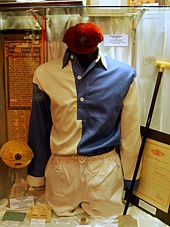For much of Liverpool's history, its home colours have been all red. When the club was founded in 1892, blue and white quartered shirts were used until the club adopted the city's colour of red in 1896.[3] The city's symbol of the liver bird was adopted as the club's badge (or crest, as it is sometimes known) in 1901, although it was not incorporated into the kit until 1955. Liverpool continued to wear red shirts and white shorts until 1964 when manager Bill Shankly decided to change to an all-red strip.[56] Liverpool played in all red for the first time against Anderlecht, as Ian St John recalled in his autobiography:
The Liverpool away strip has more often than not been all yellow or white shirts and black shorts, but there have been several exceptions. An all grey kit was introduced in 1987, which was used until the 1991–92 centenary season when it was replaced by a combination of green shirts and white shorts. After various colour combinations in the 1990s, including gold and navy, bright yellow, black and grey, and ecru, the club alternated between yellow and white away kits until the 2008–09 season, when it re-introduced the grey kit. A third kit is designed for European away matches, though it is also worn in domestic away matches on occasions when the current away kit clashes with a team's home kit. Between 2012 and 2015, the kits were designed by Warrior Sports, who became the club's kit providers at the start of the 2012–13 season.[58] In February 2015, Warrior's parent company New Balance announced it would be entering the global football market, with teams sponsored by Warrior now being outfitted by New Balance.[59] The only other branded shirts worn by the club were made by Umbro until 1985, when they were replaced by Adidas, who produced the kits until 1996 when Reebok took over. They produced the kits for 10 years before Adidas made the kits from 2006 to 2012.[60] Nike became the club's official kit supplier at the start of the 2020–21 season.[61]

Liverpool was the first English professional club to have a sponsor's logo on its shirts, after agreeing a deal with Hitachi in 1979.[62] However, for the first few years of the deal, broadcasting rules meant that sponsors logos could not be shown on shirts for televised matches.[63]
Since then the club has been sponsored by Crown Paints, Candy, Carlsberg and Standard Chartered. The contract with Carlsberg, which was signed in 1992, was the longest-lasting agreement in English top-flight football.[64] The association with Carlsberg ended at the start of the 2010–11 season, when Standard Chartered Bank became the club's sponsor.[65]
The Liverpool badge is based on the city's liver bird symbol, which in the past had been placed inside a shield. In 1977, a red liver bird standing on a football (blazoned as "Statant upon a football a Liver Bird wings elevated and addorsed holding in the beak a piece of seaweed gules") was granted as a heraldic badge by the College of Arms to the English Football League intended for use by Liverpool. However, Liverpool never made use of this badge.[66] In 1992, to commemorate the centennial of the club, a new badge was commissioned, including a representation of the Shankly Gates. The next year twin flames were added at either side, symbolic of the Hillsborough memorial outside Anfield, where an eternal flame burns in memory of those who died in the Hillsborough disaster.[67] In 2012, Warrior Sports' first Liverpool kit removed the shield and gates, returning the badge to what had adorned Liverpool shirts in the 1970s; the flames were moved to the back collar of the shirt, surrounding the number 96 for the number who died at Hillsborough.[68]

